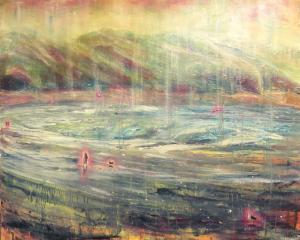The exhibition ‘‘Last Light - Looking West'' gives a glimpse into the creative evolution of pioneering abstract painter Gretchen Albrecht.
She is a highly accomplished colourist, engaging with her work and communicating through careful tonal placement, layering, and juxtaposition.
Close examination of her canvases reveals the sheer number of shades used to create depth and rounding; often, just a fraction of variance in colour can have enormous effect on the piece in its entirety.
The use of linear, geometric bars on works like Day's End (Looking West) serve to anchor the picture plane, offering something for the eye to fix upon, an endpoint.
Many of Albrecht's paintings from the early 1970s were pared-down abstract landscapes, featuring horizontal bands and slashes of bleeding colour, such as 1972's Red Sky - Golden Cloud. It is fascinating to see the 1970s work mounted alongside 2016's Last Light and The Fold in the Sky.
Albrecht's technique has matured and altered to reflect the changing preoccupations of her artistic philosophy, but there is also continuation, a sense of a perpetual circle of art and life.
One of the most absorbing works, Last Light, is curiously also one of the most muted in tone, but the textured surface and cool white, blue and grey tones combine to create a hauntingly atmospheric image. Dipping and Sweeping (Sunset), painted more than 40 years earlier, is likewise a beauty among the collection, a lyrical blending of colour.
The Hoglund Art Glass gallery is a Central Otago gem. The current work of world-renowned, Swedish-born glass artists Ola Hoglund and Marie Simberg-Hoglund is diverse, distinctive, and strikingly beautiful.
The duo are known for their expert handling of the complex, layered Graal and Sommerso techniques, which produce brilliant luminosity and depth in each piece, an intensity of colour that reaches out to draw the viewer in.
The name of Graal glass comes from the Holy Grail, the legendary chalice believed by some to offer everlasting life. The Graal process is extensive and lasts several days. Hoglund first blows a small bubble of glass, which is overlaid with layers of hot, coloured crystal glass. Simberg-Hoglund then cuts or engraves through the layers, creating images and patterns.
The piece is reheated and coated with up to five more layers of clear crystal glass, trapping air bubbles and investing each piece with a unique character, before Hoglund blows the vessel into its final size, stretching the etched design. The Sommerso technique also involves working with multiple layers of clear crystal and coloured glass.
All the works are multifaceted, morphing and blending in the shifting changes of light, with one particularly gorgeous vase having the shimmering brilliance of fish scales under water. The painted Graal vessels are bolder in tone, slightly reminiscent of 20th-century Clarice Cliff pottery, but executed with a distinctive flair and the deceptive delicacy of the medium.
Any exhibition by Madeleine Child and Philip Jarvis is guaranteed to venture into the realms of whimsy and fantasy.
‘‘Spotted'' is a fun, technicoloured explosion of spots, dots, loops and coils. The largest works feature circles of paint on sheets of hard clear plastic, and the result is unique and riveting.
Jarvis' 1 Metre Square is perhaps the standout here. The reflective curvature of the plastic gives the appearance of three-dimensional solidity, while the clustered spheres of colour have an illusion of movement, like pinpoints of light or drifting bubbles.
Jarvis' Necklaces are quirky and abstracted, yet totally identifiable. Spools of plastic coil into outsized, exaggerated jewellery, carefully detailed with more of the characteristic spots.
Nearby, his Painted Doodles seem to be caught mid-motion, arching up and sliding across the wall, the wide flat ribbons sporting geometric grids of colour. The Paint Straps that hang from the gallery walls are tangled bootlace strips of dried acrylic paint, a sort of surreal, dreamlike, pop art seaweed.
Child's STICK THINGS, ‘‘dried floral arrangements'' created from wire and painted stalks of Korari flax, have an almost futuristic vibe, while the disproportionately stretched handles of her fantastic Spotted Vessels again seem like something pulled from a dream or a children's storybook.
Many of the materials used are either common household objects or collected from nature, and the overall playfulness is enhanced by the imaginative transformation of the everyday into something a little bit magical.
-By Laura Elliot











![... we all become all of these things [installation view] (2025), by Megan Brady.](https://www.odt.co.nz/sites/default/files/styles/odt_landscape_small_related_stories/public/story/2025/03/1_we_all_become_all_of_thes.jpg?itok=SH-Q8KJZ)

